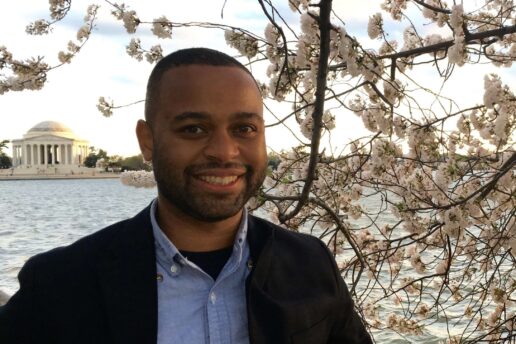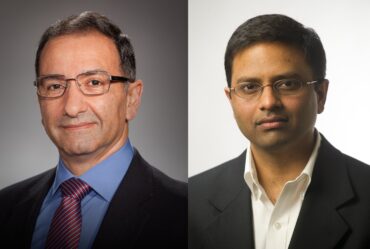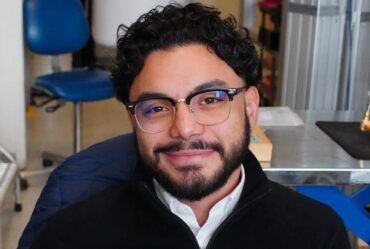
For Thomas Searles, a passion for people and science at HBCUs and MIT
Physicist and Martin Luther King Jr. Scholar is examining the optical properties of semimetals to understand how light interacts with quantum materials.
When Thomas Searles was assigned a book report in the first grade, he initially had trouble choosing a topic. He really didn’t like fiction books. After a bit of indecision, he chose to write his report on a book about Black astronauts. Though he didn’t realize it at the time, his journey to becoming a physicist at MIT had just begun.
“I looked in the book, and there was Ronald E. McNair, who happens to be an MIT alum, randomly; he got his PhD here,” Searles says. “And it said that he was a laser physicist. So, I said, ‘Well, that’s what I’m going to be, because I want to be an astronaut.’”
Searles is now a member of the 2020-21 Martin Luther King (MLK) Visiting Professors and Scholars Program cohort at MIT. Since 1995, the MLK Scholars Program has brought in a total of 67 visiting professors and 21 visiting scholars from across all academic disciplines. Individuals of any underrepresented minority group are eligible to apply, and scholars are selected for their contributions both to their fields and their potential contributions to MIT.
“It’s something that was always on my radar as a young Black scientist,” Searles said. “It was something that was on my five- to 10-year plan.”
Searles is currently an associate professor in the Department of Physics at Howard University, a historically Black college and university (HBCU) located in Washington. There, he established a new research program in applied and materials physics. He is also the director of a new academic partnership between IBM and 13 other HBCUs called the IBM-HBCU Quantum Center.
Searles’ research career began as an undergraduate in mathematics and physics at Morehouse College, a HBCU in Atlanta. Before graduating in 2005, he worked in an optics lab, examining the properties of light and its interactions with matter.
“A lot of us had an interest in optics, because that was the only experimental lab that we had at Morehouse at the time,” Searles says. “So naturally, I applied to graduate schools that were optics-related.”
That interest led him to pursue his PhD in applied physics in the Department of Electrical and Computer Engineering at Rice University in Houston, Texas, from which he graduated. Before graduating in 2011, he studied light-matter interactions, and completed a thesis about the magneto-optical properties of carbon nanotubes, tiny cylinders comprised of a single layer of carbon atoms. Carbon nanotubes are extremely strong, lightweight, and electrically conductive, making them promising for a variety of applications.
In 2015, Searles started at Howard University. “I wanted to go back and work at an HBCU. I thought of my experience working in the Morehouse optics lab and how they kind of shaped my experience,” Searles says. “So then I was like, ‘What can I do that’s different from everyone else that will also provide opportunities to a lot of Black students?’ So, I set out to start a terahertz experimental lab, knowing that it was going to be difficult. And it was difficult. But we were able to do it.”
In the terahertz spectroscopy lab at Howard University, researchers work with matter that has a large wavelength, and a frequency between several hundred gigahertz and several terahertz. During the first so-called quantum age in the mid-1900s, silicon was the new, exciting material used to develop transistors. Now, researchers in fields like chemistry and physics are on the hunt for the next material to be a platform for a new generation of quantum technologies.
“The primary goal is to study materials for new computers, making them either safer, faster, or more secure,” Searles says. “This whole idea of quantum computing is what we’re focusing our lab on, moving towards this idea of ‘quantum advantage.’”
Quantum computing relies upon the use of quantum materials — which have unique electronic and magnetic properties — to build faster, stronger, and more powerful computers. Such machines are likely to provide this “quantum advantage” for new developments in medicine, science, finance, chemistry, and many other fields.
In 2016, Searles met MIT associate professor of physics and Mitsui Career Development Professor in Contemporary Technology Joseph Checkelsky at an event through the National Science Foundation Center for Integrated Quantum Materials.
“The idea was to try to find people that we wanted to collaborate and work with,” Checkelsky says. “And I think I even wrote down in my notepad Thomas’ name and put a big underline that I should work with this guy.” Searles says the best thing that can ever happen to a spectroscopist like himself is to find “a crystal-growth person that provides samples, who you also really vibe with and like as a person. And that person for me has been Joe.” The two have been collaborating ever since.
Checkelsky’s lab works to discover new crystalline materials that enable quantum phenomena. For instance, one material that has previously been of interest to Checkelsky is a kagome crystal lattice, a 2D arrangement of iron and tin molecules. Both Checkelsky and Searles are interested in applying a branch of mathematics called topology to solids, particularly semimetals.
“One of the roles Thomas plays is to examine the optical properties of these new systems to understand how light interacts with quantum materials,” Checkelsky says. “It’s not only fundamentally important, it can also be the bridge that connects to new technologies that interfaces light with quantum science.”
Searles’ expertise on the optics side of the research enables him to identify which materials are ideal for further study, while Checkelsky’s group is able to synthesize materials with certain properties of interest.
“It’s a cycle of innovation where his lab knows how it can be tested and my lab knows how to generate the material,” Checkelsky says. “Each time we get through the cycle is another step toward answering questions in fundamental science that can also bring us to new platforms for quantum technology.”
Checkelsky nominated Searles for the MLK Scholars Program in hopes of further expanding their academic partnership. He now serves as Searles’ host researcher through the program.
“I hope to extend my collaboration with Joe to not only [explore] this condensed matter, experimental side of my group, but to expand this into Lincoln Laboratory and the quantum information portion that MIT has,” Searles says. “I think that’s critical, research-wise.”
In addition to their research goals, Searles and Checkelsky are excited to strengthen the general connection between MIT and Howard.
“I think there are opportunities for Thomas to see, for example, the graduate school process in our department,” Checkelsky says. “Along the same lines, it is a great opportunity for MIT and our department to learn more how to connect to the people and science within HBCUs. It is a great chance for information to flow both ways.”
Searles also hopes to encourage more HBCU students to pursue graduate study at MIT. “The goal of increasing the number of qualified applicants [from HBCUs] — I think that’s something that I can measure metrically from the first year,” Searles says. “And if there’s anything that I can do to help with that number, I think that would be awesome.”


